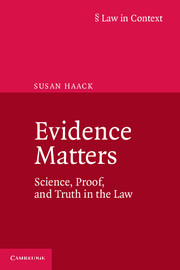Book contents
- Frontmatter
- Epigraph
- Contents
- Acknowledgments
- Introduction: A Pragmatist Perspective on Science, Proof, and Truth in the Law
- 1 Epistemology and the Law of Evidence
- 2 Epistemology Legalized
- 3 Legal Probabilism
- 4 Irreconcilable Differences? The Troubled Marriage of Science and Law
- 5 Trial and Error
- 6 Federal Philosophy of Science
- 7 Peer Review and Publication
- 8 What’s Wrong with Litigation-Driven Science?
- 9 Proving Causation
- 10 Correlation and Causation
- 11 Risky Business
- 12 Nothing Fancy
- Cases Cited
- Statutes, etc., Cited
- Bibliography
- Glossary
- Index
Introduction: A Pragmatist Perspective on Science, Proof, and Truth in the Law
Published online by Cambridge University Press: 05 August 2014
- Frontmatter
- Epigraph
- Contents
- Acknowledgments
- Introduction: A Pragmatist Perspective on Science, Proof, and Truth in the Law
- 1 Epistemology and the Law of Evidence
- 2 Epistemology Legalized
- 3 Legal Probabilism
- 4 Irreconcilable Differences? The Troubled Marriage of Science and Law
- 5 Trial and Error
- 6 Federal Philosophy of Science
- 7 Peer Review and Publication
- 8 What’s Wrong with Litigation-Driven Science?
- 9 Proving Causation
- 10 Correlation and Causation
- 11 Risky Business
- 12 Nothing Fancy
- Cases Cited
- Statutes, etc., Cited
- Bibliography
- Glossary
- Index
Summary
To be master of any branch of knowledge, you must master those which lie next to it ….
–Oliver Wendell HolmesIs truth in the law just plain truth–or is it something sui generis? Is a trial a search for truth–or is it something more, or something less, than that? Do the adversarial procedures of common-law systems promote factually sound verdicts? Do legal rules excluding relevant testimony enable the accurate determination of factual issues, or impede it? What bearing, if any, does the mathematical calculus of probabilities have on the degrees and standards of proof invoked in the law? What role can statistical evidence appropriately play in legal proof? How do the argument and counter-argument of adversarial proceedings differ from what scientists do as they seek out, sift, and weigh evidence? How can courts best handle the scientific testimony on which they now so often rely, and how are they to distinguish genuine science from pretenders–or reliable scientific testimony from unreliable hokum?
The dozen interdisciplinary essays collected here take up a whole nexus of such questions about science, proof, and truth in the law, bringing my work in epistemology and philosophy of science (and, from time to time, my work in philosophy of logic and language, metaphysics, etc.) to bear both on general questions about legal standards of proof and the relative merits of common-law and civil-law approaches to the handling of evidence, and on specific questions about the role of scientific testimony in legal proceedings. A key theme of my epistemology is that the structure of evidence can be understood by analogy with a crossword puzzle; and, just as this would lead you to expect, the arguments of these essays ramify, interlock, and loop up and back.
- Type
- Chapter
- Information
- Evidence MattersScience, Proof, and Truth in the Law, pp. xv - xxviPublisher: Cambridge University PressPrint publication year: 2014



